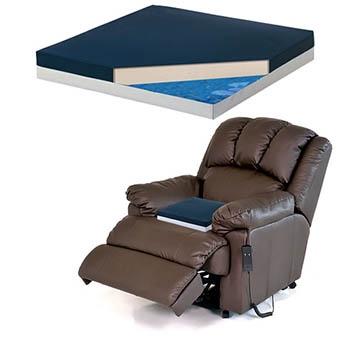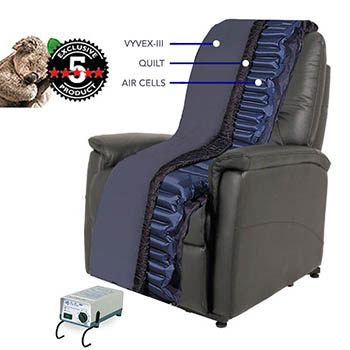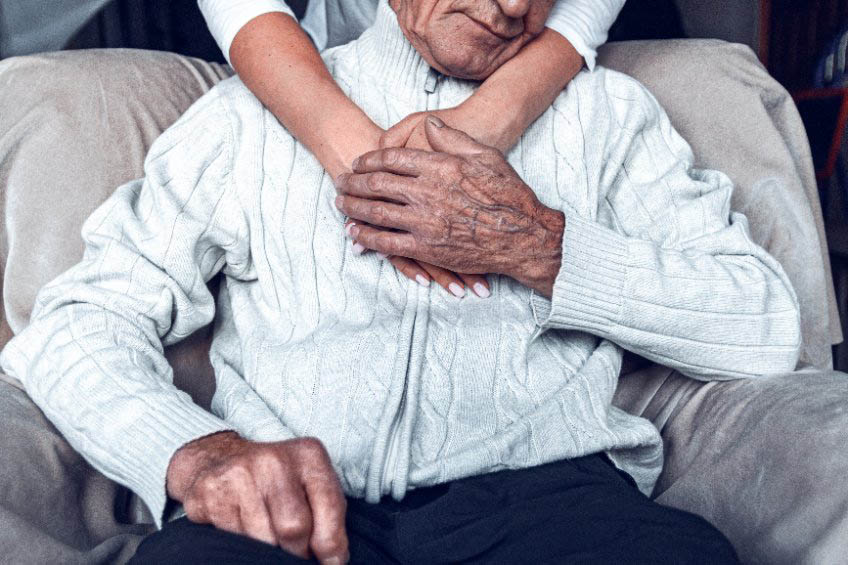Recliner Cushions for the Elderly to Prevent Bed Sores
Home recliners offer comfort and adjustable positioning. However, for the elderly or those with a medical condition that limits mobility, sitting for long periods of time in a recliner can be uncomfortable and increase the risk of developing a pressure sore. This article will discuss the best recliner cushions for the elderly.
Home recliners or lift chair cushions are not specifically designed for pressure relief or to prevent bedsores. Recliner seats do not always allow for adequate blood circulation, are often so hot people stick to them and the seat depth is often too deep, not allowing for someone to sit properly. For an elderly or immobile person, this can create pain, and discomfort and lead to skin breakdown.
Deciding which is the best recliner cushion for the elderly
Here are a few things to take into consideration:
1) Mobility - Is the older person able to reposition themselves in the recliner? The purpose of repositioning is to improve comfort and blood circulation. The more immobile an elderly person is, the greater the risk of discomfort and of developing a bedsore. Proper cushioning is essential for comfort and to prevent pressure ulcers. The type of cushion required for an elderly person is determined by their mobility.
2) Height - An elderly person's height is very important in determining the size and design of the cushion. The seat depth of a home recliner or lift chair is often too deep for most people 5' 9" or under. This can lead to improper sitting and to bedsores on the tailbone.
3) Weight - A 100 lb person has different support and comfort needs than a 250 lb person. A person's weight is essential to determine the thickness and construction of the recliner cushion.
RECLINER SEAT CUSHIONS FOR THE ELDERLY
- Seat Only
- Full Body Recliner Cushions
- Component-Based Recliner Cushions.
Which one to choose depends on a number of factors including the amount of time spent in the recliner, if the person sleeps in the recliner, where they are experiencing pain or skin breakdown, and more.
RECLINER CUSHIONS FOR SEAT ONLY

Recliner seat cushions are for the elderly or less mobile who experience discomfort or skin breakdown that is confined to the buttocks, IT's, thighs or Coccyx. The type of cushion depends on the person's weight, condition of their skin, location of the skin breakdown, or pain.
1) Comfort only, up to 250 lbs - Foam & Memory foam
2) Comfort & low risk of skin breakdown, 250 lbs - Fluidized Gel
3) Comfort & Skin Protection for low to moderate risk of skin breakdown, 250 lbs + - Bariatric Foam & Gel Flex™
4) Comfort & Skin Protection for moderate risk of skin breakdown, 400 lbs- Self Adjusting Air
5) Comfort & Skin Protection for moderate to high risk of skin breakdown, 250 lbs - Alternating Pressure Seat Cushion
FULL RECLINER OVERLAY FOR THE ELDERLY

These types of cushions provide head-to-heel comfort and skin protection. The full recliner cushions cover the entire seat, back, and foot section of the recliner. These types of recliner overlay cushions are perfect for the elderly or less mobile who experience discomfort or skin breakdown on the buttocks, IT's, thighs, coccyx, back, heels, or back of the head.
1) Comfort & Skin Protection for low risk of skin breakdown up to 250 lbs - Memory Foam Recliner Overlay
2) Comfort & low risk of skin breakdown, 250 lbs - Fluidized Gel
3) Comfort & Skin Protection for low to moderate risk of skin breakdown, 250 lbs up to 1000 lbs. - Gel-Flex™ Recliner Overlay
4) Comfort & moderate to high risk of skin breakdown on buttocks, IT's, 250 lbs - Component Gel back, Foam heel & Alternating Pressure in the seat
5) Comfort & moderate to high risk of skin breakdown, 250 lbs. - Alternating Pressure Recliner Cushion
OTHER FACTORS TO CONSIDER
1) Incontinence - Use a cushion with a waterproof, water-resistant, stain-resistant cover with either a sealed/closed seam or a zipper that has a waterfall flap (a flap of material that covers the zipper when closed). This stops body fluids from soaking the core of the cushion, is for ease of cleaning and to help prevent infection. A cushion with a fabric cover or exposed zipper should never be utilized for someone who is incontinent.
2) Positioning - Proper positioning is crucial for comfort and to prevent skin breakdown. If a person leans or is unable to sit upright, this should be considered. There are positioning cushions that help create and maintain proper positioning.
3) Thrusting - For people who thrust forward, a wedge-type cushion may help.
4) Skin Shear - Elderly and those less mobile are more prone to skin shear. This is a big problem and besides pressure, a leading cause of discomfort and bedsores. Choose a cushion that has a low shear, low friction, anti-microbial cover.
Comfort is subjective, skin protection is objective
Comfort is different for everyone. Skin protection is the same for everyone.
Everyone has a different definition of comfort. Comfort is based on individual preference. Skin protection on the other hand is based on relieving pressure to help improve blood circulation. It is the same for everyone.
Finding your "Goldilocks Zone"
The key to finding the best recliner cushion for the elderly is to balance comfort with skin protection.
The above information is to be used as a general guide. There are more factors to consider when deciding which is the best recliner seat cushion for an elderly or immobile person. It is best to speak with a product or seating specialist.
About the Author:
Jeff Adise has worked in the wound care industry for over 25 years. He is a product specialist and the developer of innovative therapeutic support surfaces for the treatment and healing of Stages I-IV pressure injuries in home recliners, lift chairs, wheelchairs, and beds. His innovative products are recommended for use by wound care specialists, physicians, caregivers, across the US. In addition, Jeff is currently collaborating with a team of Doctors and Ph.D. researchers to develop and gain FDA approval for a groundbreaking new topical drug. The promising new drug has been shown to greatly improve the quality and speed of wound healing while reducing infection.



 © 2022 Comforts Best. All Rights Reserved.
© 2022 Comforts Best. All Rights Reserved.